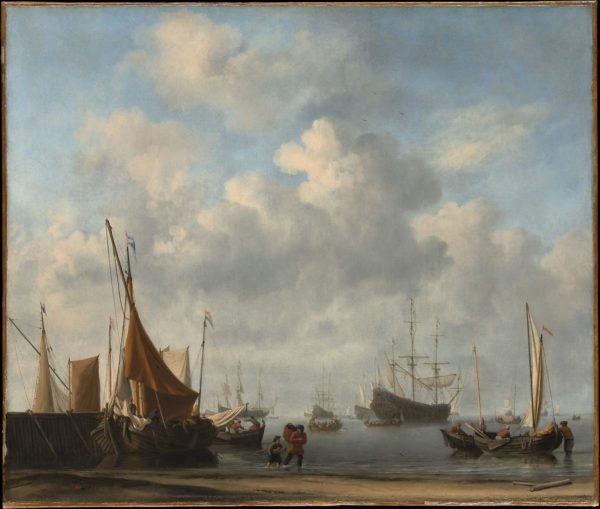
Map of the Netherlands – image source https://commons.wikimedia.org/wiki/Atlas_of_the_Netherlands#/media/File:Netherlands_pol87.jpg
You may have heard of the village of Vergenoegen located on the East Bank of Essequibo in Guyana. Did you know that the word ‘Vergenoegen’ comes from Dutch language meaning pleasure or contentment? This village along with many others such as New Amsterdam, Zeeburg, Goed Fortuin and Goedverwagting, have all received their names from the Dutch who were the first group of Europeans to create settlements Guyana.
Who are the Dutch?
The Dutch are people who come from the Netherlands. The Netherlands is also referred to as Holland. It is a country located in Northwestern Europe. This is the reason as to why they are called ‘Europeans’. They are one of the main set of Europeans that created settlements in the Caribbean and South America.
Why did the Dutch come to Guyana?

A typical Dutch Port – Image Source: https://www.metmuseum.org/art/collection/search/437876
The story of the golden city of El Dorado brought many European explorers to Guyana. This is also why the Dutch came to Guyana, along with wanting to trade with the Amerindians. The Dutch arrived early in the 17th century.
Interesting Tips:
- The word ‘Netherlands’ means low-lying country.
- There are several movies based on the myth of the Golden City of El Dorado such as The Road to El Dorado and El Dorado.
Why did they stay in Guyana?
The Dutch realized that El Dorado, city of gold did not exist and did not want to return home empty-handed. They found that trade with the Amerindians was good and that the land was very fertile.
The Creation of Dutch Settlements in Guyana
Although the Spanish were the first settlers in the Caribbean and South American, it was the Dutch who first created settlements in Guyana. Christopher Columbus had sighted the coast of Guyana on his third voyage to the West Indies but did not stop to create a settlement. Spain laid claim to this area but avoided settlements there.
The Dutch created settlements and trading posts on or near the rivers and engaged in trade with the Amerindians. They built the first fort – Fort Kyk-Over-Al, to protect their settlements. They first colonized Essequibo and then moved on to Berbice, where they built Fort Nassau. Then they finally moved to settle Demerara.
The protection from the forts enabled settlers to cultivate the lands around them. They started planting sugar cane on small scales and after observing how well it grew, began large scale production. This they did in the area that we now know as the Low Coastal Plain. With this area being below sea level, it was covered in water. The Dutch then had to build drainage systems, canals, dams and kokers to regulate the flow of the water. This is how Guyana came about having this form of drainage system.
The Dutch continued this prosperous way, establishing many plantations. They were time and again attacked by the Spanish, Portuguese and English. The three (3) colonies changed hands a few times back and forth between the Dutch and the English. Eventually, the British invaded and gained control of the colonies which they united and renamed British Guiana.

Remains of the first Dutch fort in Guyana, Fort Kyk-Over-Al | By Marco Farouk Basir, CC BY-SA 3.0, https://commons.wikimedia.org/w/index.php?curid=56433974
Some Dutch Villages in Guyana
- Zeeburg
- Vergeongen
- Uitvlugt
- New Amsterdam
- Goed Fortuin, Goed Hoop, Goed Raad, Goedverwagting
- Soesdyke
Interesting Tip
- The Dutch ‘goed’ means ‘good’ and ‘fortune’ or ‘luck’.
Forts Built By the Dutch
- Fort Nova Zeelandia – located on Fort Island.
- Fort Nassau – situated about fifty (50) miles up the Berbice River.
- Fort Kyk-Over-Al – at the junction of Essequibo, Mazaruni and Cuyuni rivers.
Important Dutch Figures in the Settling of Guyana
- Abraham Cabeliau- A sea captain who led the first known Dutch exploration to the Guyana coast.
- Adrianetz Groenewegel – Commmader of Essequibo
- Hermanus Gelskerke – Commander of Essequibo, succeeding Groenewegel
- Laurens Storm Van Gravesande – Commander of Essequibo, succeeding Gelskerke. The main person responsible for the development of Essequibo.
- Abraham Van Pere – Responsible for the settlement of Berbice.
Interesting Tips:
- Guyana’s original language was Dutch but was changed to English when the English took over the rule of the colony by the English.
- “Netherlands” means low-lying country.
- ‘Dutch Bottles’ are souvenirs that tourists like to collect. These are bottles that the Dutch planters used to drink their wine and beer from and then toss them into the rivers.
- ‘Dutch man go hold yuh’ is a saying used by many old folks to warn people from staying away from the graves of the Dutch planters.
The Dutch’s settlement of Guyana had a major impact on our history. Without the Dutch, life in Guyana would not be as it is present-day. Their settlement and development of the three colonies, Essequibo, Demerara and Berbice, led to the birth of this wonderful nation. Many things in Guyana would not be as they are without the Dutch. Many of our villages would be named differently – maybe have uninteresting names that would fail to raise curiosity and there would be no forts to visit and catch a glimpse of our history. Most importantly however, is that our main settlement area – the Low Coastal Plain, would have probably remained swamp land, failing to capture the interests of our British rulers.
Article References
- http://countrystudies.us/guyana/5.htm
- https://www.britannica.com/place/Netherlands
- https://www.britannica.com/place/Guyana/History
- https://www.stabroeknews.com/2011/05/15/features/128623/
- http://guyanachronicle.com/2013/09/28/goed-fortuin-a-quiet-little-village-on-the-westside
- https://www.landofsixpeoples.com/news301/gydutchlegacy.htm
- http://www.guyana.org/features/guyanastory/guyana_story.html







